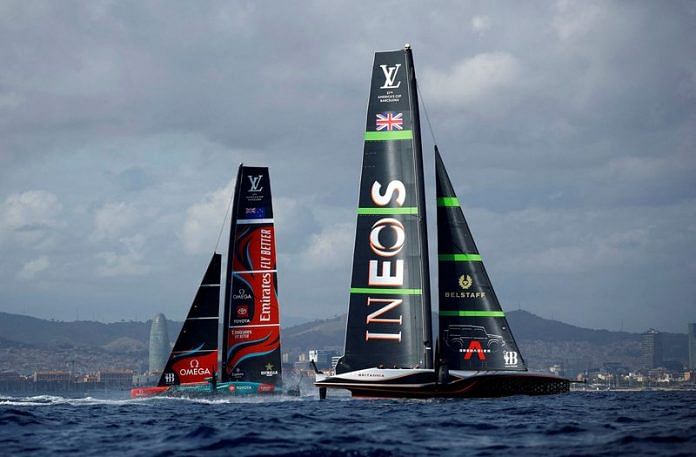By Alexander Smith
BARCELONA (Reuters) – As New Zealand and Britain set out to sea for their latest America’s Cup head-to-head, both crews will be scanning the surface for wind shifts to gain an edge in the tricky Mediterranean conditions off Barcelona.
Back ashore, viewers are able to track the breeze on screen thanks to a software developed by one of the America’s Cup sponsors to try to attract a wider audience.
This “visualisation of the wind” also links up with a race boat simulator to include a “ghost boat” showing which team is likely to gain an upper hand, giving commentators a crucial advantage over the two teams vying to win the “Auld Mug”.
Although their state-of-the-art AC75 boats have every type of electronic gizmo giving them their speed, direction and “flying” height on their foils above the water, the one thing the crews are not allowed on board is live weather data.
The wind “Lidar” system IT company Capgemini has set up in Barcelona uses pulses of light which reflect back off particles in the air, enabling them to calculate speed and direction.
“Each of the Lidars that we’ve got emits 10,000 pulses per second. We’ve got three of these machines, so we’re effectively pulsing the Barcelona bay with 30,000 beams every second,” said Keith Williams, Capgemini’s chief engineer for WindSight IQ.
The beams are “completely eye safe”, Williams added of the equipment, which he said is often used for planning wind farms or to detect significant wind shear at the end of a runway.
“We’re effectively putting just under a quarter of a million wind sensors on the course,” Williams, who is a keen sailor, told Reuters, adding that the system uses an algorithm to give an accurate representation of the wind field in real time.
The big question is: are the crews getting it right?
“Quite often we look at it and say: ‘that was not the right call’,” Williams said of being able to watch the tactics as the races unfold and the wind patterns develop.
“For people who are not familiar with the sport, understanding what the wind is like on the course, that makes a big difference,” Williams said, adding that the application could be used by almost any sport where wind is a factor.
“I think you’ve got applications both in the broadcast of sport, but also in the R&D (research and development) inside sport,” he said, naming American Football, Formula One, golf, rugby and even ski-jumping as some sports where the technology could be used.
Other potential applications include air taxis in built-up urban areas and tackling wild fires, he said.
(Reporting by Alexander Smith; Editing by Andrew Cawthorne)
Disclaimer: This report is auto generated from the Reuters news service. ThePrint holds no responsibilty for its content.



